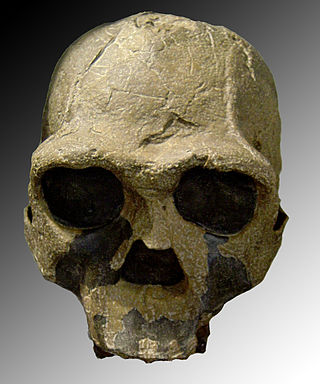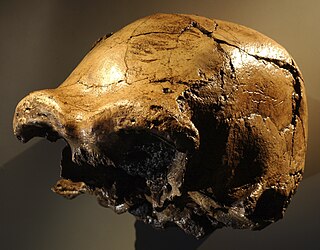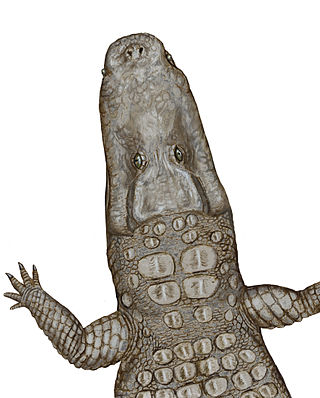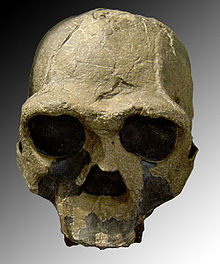
Homo habilis is an extinct species of archaic human from the Early Pleistocene of East and South Africa about 2.3 million years ago to 1.65 million years ago (mya). Upon species description in 1964, H. habilis was highly contested, with many researchers recommending it be synonymised with Australopithecus africanus, the only other early hominin known at the time, but H. habilis received more recognition as time went on and more relevant discoveries were made. By the 1980s, H. habilis was proposed to have been a human ancestor, directly evolving into Homo erectus, which directly led to modern humans. This viewpoint is now debated. Several specimens with insecure species identification were assigned to H. habilis, leading to arguments for splitting, namely into "H. rudolfensis" and "H. gautengensis" of which only the former has received wide support.

Richard Erskine Frere Leakey was a Kenyan paleoanthropologist, conservationist and politician. Leakey held a number of official positions in Kenya, mostly in institutions of archaeology and wildlife conservation. He was Director of the National Museum of Kenya, founded the NGO WildlifeDirect, and was the chairman of the Kenya Wildlife Service. Leakey served in the powerful office of cabinet secretary and head of public service during the tail end of President Daniel Toroitich Arap Moi's government.

Homo ergaster is an extinct species or subspecies of archaic humans who lived in Africa in the Early Pleistocene. Whether H. ergaster constitutes a species of its own or should be subsumed into H. erectus is an ongoing and unresolved dispute within palaeoanthropology. Proponents of synonymisation typically designate H. ergaster as "African Homo erectus" or "Homo erectus ergaster". The name Homo ergaster roughly translates to "working man", a reference to the more advanced tools used by the species in comparison to those of their ancestors. The fossil range of H. ergaster mainly covers the period of 1.7 to 1.4 million years ago, though a broader time range is possible. Though fossils are known from across East and Southern Africa, most H. ergaster fossils have been found along the shores of Lake Turkana in Kenya. There are later African fossils, some younger than 1 million years ago, that indicate long-term anatomical continuity, though it is unclear if they can be formally regarded as H. ergaster specimens. As a chronospecies, H. ergaster may have persisted to as late as 600,000 years ago, when new lineages of Homo arose in Africa.

Homo rudolfensis is an extinct species of archaic human from the Early Pleistocene of East Africa about 2 million years ago (mya). Because H. rudolfensis coexisted with several other hominins, it is debated what specimens can be confidently assigned to this species beyond the lectotype skull KNM-ER 1470 and other partial skull aspects. No bodily remains are definitively assigned to H. rudolfensis. Consequently, both its generic classification and validity are debated without any wide consensus, with some recommending the species to actually belong to the genus Australopithecus as A. rudolfensis or Kenyanthropus as K. rudolfensis, or that it is synonymous with the contemporaneous and anatomically similar H. habilis.
Paleoanthropology or paleo-anthropology is a branch of paleontology and anthropology which seeks to understand the early development of anatomically modern humans, a process known as hominization, through the reconstruction of evolutionary kinship lines within the family Hominidae, working from biological evidence and cultural evidence.
Turkana Boy, also called Nariokotome Boy, is the name given to fossil KNM-WT 15000, a nearly complete skeleton of a Homo ergaster youth who lived 1.5 to 1.6 million years ago. This specimen is the most complete early hominin skeleton ever found. It was discovered in 1984 by Kamoya Kimeu on the bank of the Nariokotome River near Lake Turkana in Kenya.

Paranthropus aethiopicus is an extinct species of robust australopithecine from the Late Pliocene to Early Pleistocene of East Africa about 2.7–2.3 million years ago. However, it is much debated whether or not Paranthropus is an invalid grouping and is synonymous with Australopithecus, so the species is also often classified as Australopithecus aethiopicus. Whatever the case, it is considered to have been the ancestor of the much more robust P. boisei. It is debated if P. aethiopicus should be subsumed under P. boisei, and the terms P. boisei sensu lato and P. boisei sensu stricto can be used to respectively include and exclude P. aethiopicus from P. boisei.

Paranthropus boisei is a species of australopithecine from the Early Pleistocene of East Africa about 2.5 to 1.15 million years ago. The holotype specimen, OH 5, was discovered by palaeoanthropologist Mary Leakey in 1959 at Olduvai Gorge, Tanzania and described by her husband Louis a month later. It was originally placed into its own genus as "Zinjanthropus boisei", but is now relegated to Paranthropus along with other robust australopithecines. However, it is also argued that Paranthropus is an invalid grouping and synonymous with Australopithecus, so the species is also often classified as Australopithecus boisei.
Kamoya Kimeu was a Kenyan paleontologist and curator, whose contributions to the field of paleoanthropology were recognised with the National Geographic Society's LaGorce Medal and with an honorary doctorate of science degree from Case Western Reserve University.

Koobi Fora refers primarily to a region around Koobi Fora Ridge, located on the eastern shore of Lake Turkana in the territory of the nomadic Gabbra people. According to the National Museums of Kenya, the name comes from the Gabbra language:
In the language of the Gabbra people who live near the site, the term Koobi Fora means a place of the commiphora and the source of myrrh...

KNM ER 1813 is a skull of the species Homo habilis. It was discovered in Koobi Fora, Kenya by Kamoya Kimeu in 1973, and is estimated to be 1.9 million years old.

KNM ER 1805 is the catalog number given to several pieces of a fossilized skull of the species Homo habilis. It was discovered in Koobi Fora, Kenya in 1974. The designation indicates specimen 1805, collected from the east shore of Lake Rudolf for the Kenya National Museums.

KNM ER 406 is an almost complete fossilized skull of the species Paranthropus boisei. It was discovered in Koobi Fora, Kenya by Richard Leakey and H. Mutua in 1969. This species is grouped with the Australopitecine genus, Paranthropus boisei because of the robusticity of the skull and the prominent characteristics. This species was found well preserved with a complete cranium but lacking dentition. He was known for his robust cranial features that showed the signs of adaptation of the ecological niches. The big chewing muscles attached to the sagittal crest are traits of this adaptation.

KNM ER 992 is a 1.5 million years old fossilized lower jaw discovered by Richard Leakey in 1971 at Lake Turkana, Kenya. The mandible was considered by C. Groves and V. Mazak to be the holotype specimen for Homo ergaster.

Homo erectus is an extinct species of archaic human from the Pleistocene, with its earliest occurrence about 2 million years ago. Its specimens are among the first recognizable members of the genus Homo.
Ileret is a village in Marsabit County, Kenya. It is located in Northern Kenya, on the eastern shore of Lake Turkana, north of Sibiloi National Park and near the Ethiopian border.

The Daka calvaria, otherwise known as the Dakaskull, or specimen number BOU-VP-2/66, is a Homo erectus specimen from the Daka Member of the Bouri Formation in the Middle Awash Study Area of the Ethiopian Rift Valley.

Crocodylus thorbjarnarsoni is an extinct species of crocodile from the Pliocene and Pleistocene of the Turkana Basin in Kenya. It is closely related to the species Crocodylus anthropophagus, which lived during the same time in Tanzania. C. thorbjarnarsoni could be the largest known true crocodile, with the largest skull found indicating a possible total length up to 7.6 m (25 ft). It may have been a predator of early hominins. Crocodylus thorbjarnarsoni was named by Christopher Brochu and Glenn Storrs in 2012 in honor of John Thorbjarnarson, a conservationist who worked to protect endangered crocodilians.

KNM ER 3883 is the catalogue number of a fossilized skull of the species Homo ergaster. The fossil was discovered by Richard Leakey in 1976 in Koobi Fora, east of Lake Turkana, Kenya.
The KBS Tuff is an ash layer in East African Rift Valley sediments, derived from a volcanic eruption that occurred approximately 1.87 million years ago (Ma). The tuff is widely distributed geographically, and marks a significant transition between water flow and associated environmental conditions around Lake Turkana shortly after 2 Ma.
















